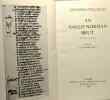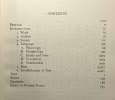9 books for « alexander bell »Edit
-
Century
19th (4)
20th (5)
-
Topics
Belief (1)
Bruyère (1)
Ethnology (1)
Faith (1)
Linguistics (1)
Literature (1)
Physics (2)
Sciences (1)
Solomon (1)
Sue eugène (1)
Tea (3)
Technology (2)
-
Countries
Denmark (4)
France (5)
-
Syndicate
ILAB (5)
SLAM (1)
An anglo-norman brut (royal 13. A. xxi) - anglo-norman texts XXI-XXII
Anglo-Norman text society 1969 in8. 1969. Cartonné.
Bon état couverture défraîchie intérieur propre texte en anglais et anglo-norman
Loraine John Alexander Bell Edwin Trevor
Reference : 100070438
(1971)
ISBN : 0443007381
Hormone Assays and Their Clinical Application
Harcourt Brace/Churchill Livingstone 1971 703 pages 17x23x3cm. 1971. Cartonné jaquette. 703 pages.
bon état général intérieur propre jaquette frottée sur ses bords accroc en haut de son dos
"BELL, ALEXANDRE (ALEXANDER) GRAHAM. - BELL, ALEXANDER GRAHAM. - ""THE GREATEST INVENTION I HAVE EVER MADE"": THE PHOTOPHONE.
Reference : 48149
(1880)
De la Production et de la Reproduction du Son par la Lumière. Mémoire lu à l'Association américaine pour l'avancement des Sciences, au Congrès de Boston, le 27 août 1880. (+) Les Récepteurs photophoniques de Sélénium. (Cette Note fait suite au M´wem...
Paris, G. Masson, 1880. 8vo. Contemp. hcalf, raised bands, gilt spine. Light wear along edges. Small stamps on verso of titlepage. In: ""Annales de Chimie et de Physique"", 5e Series, Tome 21. 576 pp. and 2 folded engraved plates. (Entire volume offered). Bell's paper: 399-430. With 11 fine textillustrations (showing the apparatus). Clean and fine.
First French version of ""On the Production and Reproduction of Sound by Light"" (the French version published in November and the English in October 1880) of this importent paper in which Bell describes his and Charles Sumner Tainter's, his assistent, invention of the Photophone or Radiophone, THE PROGENITOR OF MODERN FIBER OPTICS. This invention made possible the world's FIRST WIRELESS TELEPHONE MESSAGE, and the first call was sent from the Franklin Scool to the window of Bell's laboratory, some 213 meter away.Also with Breguet's importent paper on the Selenium used in the technology.""On June 3, 1880, Alexander Graham Bell transmitted the first wireless telephone message on his newly invented ""photophone."" Bell believed the photophone was his most important invention. The device allowed for the transmission of sound on a beam of light. Of the eighteen patents granted in Bell's name alone, and the twelve he shared with his collaborators, four were for the photophone. Bell's photophone worked by projecting voice through an instrument toward a mirror. Vibrations in the voice caused similar vibrations in the mirror. Bell directed sunlight into the mirror, which captured and projected the mirror's vibrations. The vibrations were transformed back into sound at the receiving end of the projection. The photophone functioned similarly to the telephone, except the photophone used light as a means of projecting the information, while the telephone relied on electricity."" (Mary Bellis).The first successful attempts were based upon the properties of selenium: ""The electric resistance of which varies with the degree of illumination to which it is exposed. Hence, given a transmitting instrument, such as a flexible mirror, by which the vibrations of a sound could throw into vibrations a beam of light, a receiver, consisting of sensitive selenium, forming part of an electric circuit with a battery and a telephone, should suffice to translate the varying intensities of light into corresponding varying intensities of electric current, and finally into vibrations of the telephone disk audible once more as sound."" (Prescott, George. Bell's Electric Speaking Telephone. 313 p.).
"BELL, ALEXANDER GRAHAM. - ""THE GREATEST INVENTION I HAVE EVER MADE"": THE PHOTOPHONE.
Reference : 46951
(1880)
On the Production and Reproduction of Sound by Light. (Read before the American Association for the Advancement of Science, in Boston, August 27, 1880).
(New Haven), 1880. 8vo. Modern plain wrappers. In: American Journal of Science"", Third series, Vol. XX, No. 118, October 1880. Frontispiece-plate. Pp. 257-352 (entire issue offered). Bell's paper: pp. 305-324 and 11 textillustrations. A small stamp to verso of plate and the first leaf.
First printing of this important paper in which Bell describes his and Charles Sumner Tainter's, his assistent, invention of the Photophone or Radiophone, THE PROGENITOR OF MODERN FIBER OPTICS. This invention made possible the world's FIRST WIRELESS TELEPHONE MESSAGE, and the first call was sent from the Franklin Scool to the window of Bell's laboratory, some 213 meter away.""On June 3, 1880, Alexander Graham Bell transmitted the first wireless telephone message on his newly invented ""photophone."" Bell believed the photophone was his most important invention. The device allowed for the transmission of sound on a beam of light. Of the eighteen patents granted in Bell's name alone, and the twelve he shared with his collaborators, four were for the photophone. Bell's photophone worked by projecting voice through an instrument toward a mirror. Vibrations in the voice caused similar vibrations in the mirror. Bell directed sunlight into the mirror, which captured and projected the mirror's vibrations. The vibrations were transformed back into sound at the receiving end of the projection. The photophone functioned similarly to the telephone, except the photophone used light as a means of projecting the information, while the telephone relied on electricity."" (Mary Bellis).The first successful attempts were based upon the properties of selenium: ""The electric resistance of which varies with the degree of illumination to which it is exposed. Hence, given a transmitting instrument, such as a flexible mirror, by which the vibrations of a sound could throw into vibrations a beam of light, a receiver, consisting of sensitive selenium, forming part of an electric circuit with a battery and a telephone, should suffice to translate the varying intensities of light into corresponding varying intensities of electric current, and finally into vibrations of the telephone disk audible once more as sound."" (Prescott, George. Bell's Electric Speaking Telephone. 313 p.).
Bell (Colin) and Encel (Solomon), eds. - Hugh Stretton - Lois Bryson and Faith Thompson - Eva Cox, Fran Hausfield and Sue Wills - Bettina Cass, Madge Watson, Heather Radi, Diana Temple, Sue Wills and Anne Winkler - Alexander F. Mamak - Ron Wild - Bill Bottomley - Hannah Middleton
Reference : 64405
(1978)
Inside the Whale - Ten Personal Accounts of Social Research
Pergamon Press Malicorne sur Sarthe, 72, Pays de la Loire, France 1978 Book condition, Etat : Bon paperback, editor's illustrated wrappers In-8 1 vol. - 277 pages
Contents, Chapitres : Preface, contents, iv, Text, 273 pages - Colin Bell and S. Encel : Introduction - Colin Bell : Studying the locally powerful, personal reflections on a research career - S. Encel : In search of power - Hugh Stretton : Capital mistakes - Lois Bryson and Faith Thompson : Reflections of an Australian Newtonn - Eva Cox, Fran Hausfield and Sue Wills : Taking the Queen's shilling, accepting social research consultancies in the 1970's - Bettina Cass, Madge Watson, Heather Radi, Diana Temple, Sue Wills and Anne Winkler : Working it together, researching academic women - Alexander F. Mamak : Nationalism, race-class consciousness and social research on Bougainville Island, Papua New Guinea - Ron Wild : The background to Bradstow, reflections and reactions - Bill Bottomley : Words, deeds and postgraduate research - Hannah Middleton : A marxist at Wattie Creek : Fieldwork among Australian Aborigines near fine copy, no markings
"BELL, ALEXANDER GRAHAM. - THE PHOTOPHONE AND SPECTRAL ANALYSIS.
Reference : 48148
(1880)
Sur l'application du photophone à l'étude des bruits qui ont lieu à la surface solaire. Note présentée par M. Janssen au nom de Alex. Graham Bell.
(Paris, Gauthier-Villars), 1880. 4to. No wrappers. In: ""Comptes Rendus Hebdomadaires des Séances de L'Academie des Sciences"", Tome 91, No 18. Pp.(698-) 736. (Entire issue offered). Bell's paper: pp. 726-727.
First printing of the paper in which Bell speculates how his and Tainter's invention of the Photophone or Radiophone could have a wider use. He pondered the photophone's possible scientific use in the spectral analysis of artificial light sources, stars and sunspots. He later also speculated on its possible future applications, though he did not anticipate either the laser or fiber-optic telecommunications:""Can Imagination picture what the future of this invention is to be!.... We may talk by light to any visible distance without any conduction wire.... In general science, discoveries will be make by the Photophone that are undreamed of just now."" Not long after its invention laboratories within the Bell System continued to improve the photophone in the hope that it could supplement or replace expensive conventional telephone lines. Its earliest non-experimental use came with military communication systems during World War I and II, its key advantage being that its light-based transmissions could not be intercepted by the enemy.
D'une Modification du Microphone de Wheatstone et de la Possibilité d'appliquer cet Instrument a des Recherches radiophoniques.
Paris, G. Masson, 1882. 8vo. Contemp. hcalf, raised bands, gilt spine. Light wear along edges. Small stamps on verso of titlepage. In: ""Annales de Chimie et de Physique"", 5e Series, Tome 25. 576 pp. and 1 folded engraved plates. (Entire volume offered). Bell's paper: pp. 135-139 a. 2 textillustrations.
First French edition of Bell's paper read before the Philosophical Society of Washington, D.C., June 11, 1881.
An Anglo-Norman Brut (Royal 13.A.xxi)
Oxford, Anglo-Norman Text Society, 1969. In-8, cart. éd. vert, titre doré, 200 pp., 1 pl. au front, texte en anglais et français ancien, notes, glossaire et index.
Collection Anglo-Norman Text - 21-22. Comme neuf. - Frais de port : -France 6,9 € -U.E. 9 € -Monde (z B : 15 €) (z C : 25 €)
An Anglo-Norman Brut (Royal 13.A.xxi)
Oxford, 1969, in-8, 200pp, Reliure éditeur, Très bel exemplaire! 200pp
 Write to the booksellers
Write to the booksellers






